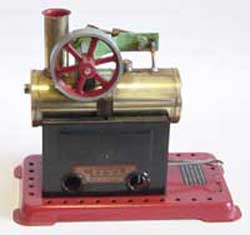
Toy Steam Glossary
|
The intent of this glossary is to help familarize those new to toy steam engines with the various parts that make up the engine and the function of each part in a simple manner.
Boiler - a chamber in which water is heated to produce steam. Boiler Bushing - boiler tubes and end plates are not thick enough to thread so a thicker fitting is fastened in the hole, used for whistles, safety valves, sight glasses etc. Bore - the inside diameter of a piston cylinder. Connecting Rod - the length of rod that connects a piston to the throw on a crankshaft. Crankshaft - the main shaft of an engine with an eccentric pin that determines the stroke of the piston. Cylinder - the tube that surrounds the piston, steam enters and exhausts through ports to drive the piston. Governor - a rotating decice with weights fastened to arms that are designed to move with centrifical force to control the speed of an engine, most governors on toy steam engines are for decoration only. Double Acting Piston - a piston that is pushed on both directions of the stroke by the steam giving more power to the engine. End Cap - disks that close the ends of a boiler tube. Firebox - an enclosure under the boiler for a heating source. Flywheel - a weighted wheel that maintains inertia of the engine between strokes of the piston. Flues - one or more tubes that run through a boiler to help distribute the heat from the firebox. Lagging - a covering to retain the temperature of the steam such as wrapping a steam line with cotton string or covering a boiler with wooden strips. Also prevents burnt fingers from hot steam lines.
Methanol - a type of alcohol used in burners as a fuel to heat the water in a boiler, also known as methyl alcohol, wood alcohol, methyl hydrate, wood naphtha or wood spirits. Oscillating Cylinder - a cylinder with a pivot bolt, the steam entry and exhaust is controlled as the cylinder rocks past the ports. Safety Valve - a pressure release mechanism to prevent the steam pressure from building up past a determined level in the boiler. They may be spring loaded or controled by a weight hanging on an arm. Sight Glass - a glass tube or round disk mounted on a boiler to gauge the water level. Single Acting Piston - a piston that is driven one way by the steam and is driven by the flywheel on the return stroke. Slide Valve - valve that opens and closes a passageway by sliding over a port, most often controled by a cam on the crankshaft. Slip Eccentric - a slotted cam that automatically changes the timing of a slide valve so the engine will run in reverse. Smoke Stack - a tube that sits on the top of a boiler or firebox to act as a chimney, most are for decoration only on toy engines, some engine cylinders exhaust into them. Steam Chest - the chamber from which steam is distributed to the cylinder. Steam Dome - a chamber on top of the boiler from which steam is conducted to the cylinder. Stroke - the distance a piston moves with each revolution of the crankshaft. Throttle Valve - a valve that restricts the flow of steam to control the speed of the engine, on some models they are placed on the exhaust line. Throw - the distance between the center of a crankshaft and the center of the eccentric pin, equal to 1/2 the distance of the stroke. Whistle - a tube mounted on a valve designed so that when the valve is opened the steam pressure makes a whisling sound. Generally used on toy steam engines to determine how much pressure is in the boiler by the intensity of the sound. |
|
